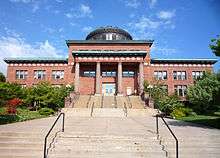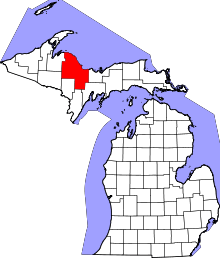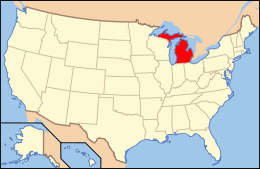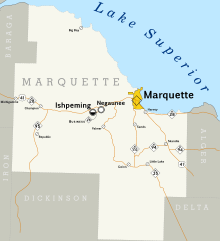Marquette County, Michigan
| Marquette County, Michigan | |
|---|---|
 Marquette County Courthouse was used in the film version of Anatomy of a Murder, which was set in the area. | |
 Location in the U.S. state of Michigan | |
 Michigan's location in the U.S. | |
| Founded | March 9, 1843, organized 1851[1] |
| Named for | Jacques Marquette |
| Seat | Marquette |
| Largest city | Marquette |
| Area | |
| • Total | 3,425 sq mi (8,871 km2) |
| • Land | 1,808 sq mi (4,683 km2) |
| • Water | 1,616 sq mi (4,185 km2), 47% |
| Population | |
| • (2010) | 67,077 |
| • Density | 37/sq mi (14/km²) |
| Congressional district | 1st |
| Time zone | Eastern: UTC-5/-4 |
| Website |
www |
Marquette County is a county located in the Upper Peninsula of the US state of Michigan. As of the 2010 census, the population was 67,077.[2] The county seat is Marquette.[3] The county is named for Father Marquette, a Jesuit missionary. It was set off in 1843 and organized in 1851.[1] Marquette County is the largest county in land area in Michigan, and the most populous county in the Upper Peninsula of Michigan.
Marquette County comprises the Marquette, MI Micropolitan Statistical Area.
Geography
According to the U.S. Census Bureau, the county has a total area of 3,425 square miles (8,870 km2), of which 1,808 square miles (4,680 km2) is land and 1,616 square miles (4,190 km2) (47%) is water.[4] It is the largest county in Michigan by land area and fourth-largest by total area.
The Huron Mountains are located in the county. To the north of the county is Lake Superior.
Adjacent counties
- Alger County (east)
- Delta County (southeast)
- Menominee County (south/CST Border)
- Dickinson County (south/CST Border)
- Iron County (southwest/CST Border)
- Baraga County (west)
- Houghton County (northwest)
- Keweenaw County (north)
National protected areas
Major highways

In addition to the 169.42 miles (272.66 km) of state highways in the county, the Marquette County Road Commission maintains 283.85 miles (456.81 km) of primary county roads which include County Road 492 (CR 492), and 988.25 miles (1,590.43 km) of secondary county roads. The road commission provides maintenance such as snow removal under contract with the Michigan Department of Transportation for the state trunklines.[5] The commission was also planning to build CR 595 in the next few years.[6] The project was canceled after the permit was denied by the Michigan Department of Environmental Quality and the funding for the project was diverted by the commercial interests backing construction.[7]
Demographics
| Historical population | |||
|---|---|---|---|
| Census | Pop. | %± | |
| 1850 | 136 | — | |
| 1860 | 2,821 | 1,974.3% | |
| 1870 | 15,033 | 432.9% | |
| 1880 | 25,394 | 68.9% | |
| 1890 | 39,521 | 55.6% | |
| 1900 | 41,239 | 4.3% | |
| 1910 | 46,739 | 13.3% | |
| 1920 | 45,786 | −2.0% | |
| 1930 | 44,076 | −3.7% | |
| 1940 | 47,144 | 7.0% | |
| 1950 | 47,654 | 1.1% | |
| 1960 | 56,154 | 17.8% | |
| 1970 | 64,686 | 15.2% | |
| 1980 | 74,101 | 14.6% | |
| 1990 | 70,887 | −4.3% | |
| 2000 | 64,634 | −8.8% | |
| 2010 | 67,077 | 3.8% | |
| Est. 2015 | 67,215 | [8] | 0.2% |
| U.S. Decennial Census[9] 1790-1960[10] 1900-1990[11] 1990-2000[12] 2010-2013[2] | |||
The 2010 United States Census,[13] indicates Marquette County had a population of 67,077. This is an increase of 2,443 people from 2000, representing a growth of 3.8%. In 2010 there were 27,538 households and 16,664 families residing in the county. The population density was 37 people per square mile (16/km²). There were 34,330 housing units at an average density of 19 per square mile (8/km²). 93.8% of the population were White, 1.7% Native American, 1.7% Black or African American, 0.6% Asian, 0.2% of some other race and 2.0% of two or more races. 1.1% were Hispanic or Latino (of any race). 18.8% were of Finnish, 13.3% German, 10.5% French, French Canadian or Cajun, 9.3% English, 6.8% Italian, 6.2% Irish and 5.8% Swedish ancestry.[14]
There were 27,538 households out of which 23.4% had children under the age of 18 living with them, 47.8% were married couples living together, 8.6% had a female householder with no husband present, and 39.5% were non-families. 20.4% of all households were made up of individuals and 10.6% had someone living alone who was 65 years of age or older. The average household size was 2.26 and the average family size was 2.81.
In 2010, the age distribution of the county was as follows:18.7% were under the age of 18, 14.8% from 18 to 24, 23.0% from 25 to 44, 28.9% from 45 to 64, and 14.7% were 65 years of age or older. The median age was 39.4 years. The population is 50.5% male and 49.5% female.
The median income for a household in the county was $46,875, and the median income for a family was $52,083. The per capita income for the county was $22,170. About 6.4% of families and 12.5% of the population were below the poverty line, including 20.3% of those under age 18 and 12.5% of those age 65 or over.
Government
The county government operates the jail, KI Sawyer International Airport, maintains rural roads, operates the major local courts, keeps files of deeds and mortgages, maintains vital records, administers public health regulations, and participates with the state in the provision of welfare and other social services. The county board of commissioners controls the budget but has only limited authority to make laws or ordinances. In Michigan, most local government functions – police and fire, building and zoning, tax assessment, street maintenance, etc. — are the responsibility of individual cities and townships.
Elected officials
- Prosecuting Attorney: Matthew Wiese
- Sheriff: Michael H. Lovelace
- County Clerk: Linda Talsma
- County Treasurer: Anne Giroux
- Register of Deeds: Carla L'Huillier
- Drain Commissioner: P. Michael Farrell
- Mine Inspector: John Carlson
(information as of June 2013)[15]
Education
Northern Michigan University is a four-year university, established in 1899, located in Marquette, Michigan, on Michigan's Upper Peninsula. The school is home to over 9,000 students and offers over 100 academic programs leading to degrees at the levels of bachelor, associate, certificate, as well as several graduate programs. Their Teaching, Learning and Communication (TLC) program, which is the largest of its kind in the country, gives every student an IBM ThinkPad or Apple MacBook. NMU has the world's largest wooden dome, the Superior Dome. It is also home to the United States Olympic Education Center, or USOEC, one of only four US Olympic training centers and the only one affiliated with a university. Athletes receive scholarships and utilize the school's facilities training in several sports: Men's and Women's Weightlifting; Boxing; Men's and Women's Speedskating; Greco-Roman Wrestling; and Women's Freestyle Wrestling.
Historical markers
There are ten historical markers in the County,[16] namely:
- Cliffs Shaft Mine
- Dandelion Cottage
- Father Marquette Park
- First Steam Railroad in Upper Peninsula
- Ishpeming: Historic Ski Center
- Jackson Mine
- Marquette County Courthouse
- Marquette Iron Range
- Northern Michigan University
- Sam Cohodas Lodge / Sam Cohodas
Communities
Cities
Unincorporated communities
Townships
- Champion Township
- Chocolay Charter Township
- Ely Township
- Ewing Township
- Forsyth Township
- Humboldt Township
- Ishpeming Township
- Marquette Township
- Michigamme Township
- Negaunee Township
- Powell Township
- Republic Township
- Richmond Township
- Sands Township
- Skandia Township
- Tilden Township
- Turin Township
- Wells Township
- West Branch Township
See also
- List of Michigan State Historic Sites in Marquette County, Michigan
- National Register of Historic Places listings in Marquette County, Michigan
References
- 1 2 "Bibliography on Marquette County". Clarke Historical Library, Central Michigan University. Retrieved January 20, 2013.
- 1 2 "State & County QuickFacts". United States Census Bureau. Retrieved August 28, 2013.
- ↑ "Find a County". National Association of Counties. Retrieved 2011-06-07.
- ↑ "2010 Census Gazetteer Files". United States Census Bureau. August 22, 2012. Retrieved September 27, 2014.
- ↑ Staff (2009). "Welcome to the Marquette County Road Commission". Marquette County Road Commission. Retrieved April 15, 2012.
- ↑ McLaren, Noël (October 18, 2010). "County Road 595 Approved for Planning". Negaunee, MI: WLUC-TV. Retrieved April 15, 2012.
- ↑ Pepin, John (January 4, 2013). "CR 595 Project Killed". The Mining Journal. Marquette, MI. pp. 1A, 8A. ISSN 0898-4964. Archived from the original on January 4, 2013. Retrieved January 4, 2013.
- ↑ "County Totals Dataset: Population, Population Change and Estimated Components of Population Change: April 1, 2010 to July 1, 2015". Retrieved July 2, 2016.
- ↑ "U.S. Decennial Census". United States Census Bureau. Retrieved September 27, 2014.
- ↑ "Historical Census Browser". University of Virginia Library. Retrieved September 27, 2014.
- ↑ "Population of Counties by Decennial Census: 1900 to 1990". United States Census Bureau. Retrieved September 27, 2014.
- ↑ "Census 2000 PHC-T-4. Ranking Tables for Counties: 1990 and 2000" (PDF). United States Census Bureau. Retrieved September 27, 2014.
- ↑ "Census 2010 American Fact Finder". Retrieved June 15, 2013.
- ↑ Data Access and Dissemination Systems (DADS). "American FactFinder". census.gov.
- ↑ "Marquette County Department Directory". Retrieved June 15, 2013.
- ↑ "Michigan Historical Markers". michmarkers.com.
External links
 |
Houghton County | Lake Superior; Keweenaw County |  | |
| Baraga County | |
Alger County | ||
| ||||
| | ||||
| Iron County | Menominee and Dickinson counties | Delta County |
Coordinates: 46°40′N 87°36′W / 46.66°N 87.60°W